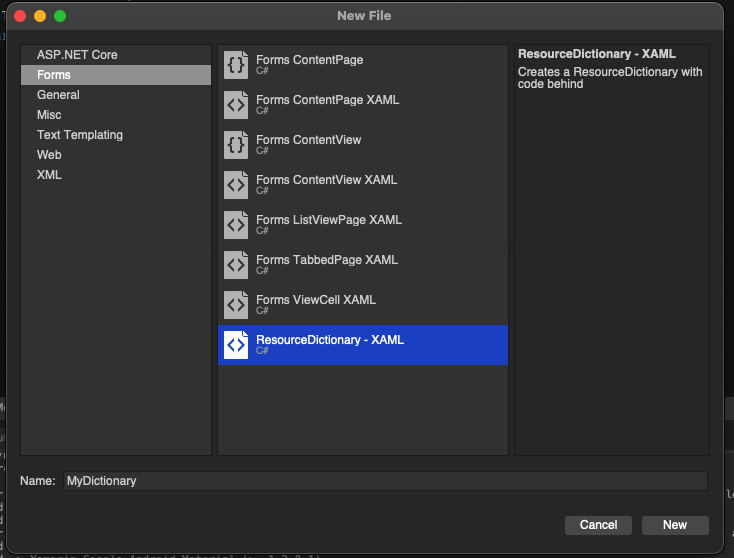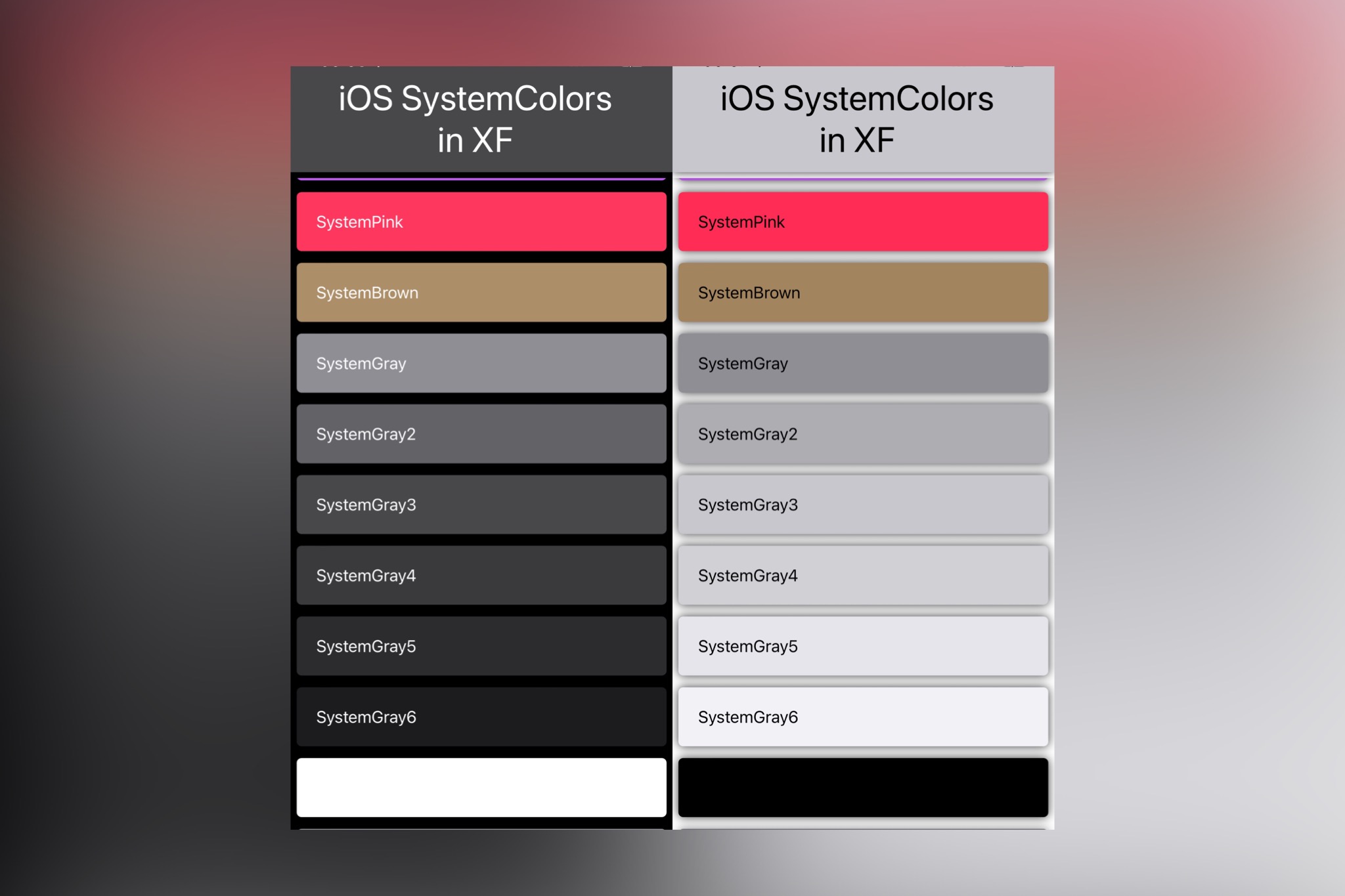Use the iOS system colors in Xamarin.Forms (Updated)
Update
After publishing this post, Gerald Versluis from Microsoft responded on Twitter with an interesting information on how to get the system colors into our ResourceDictionary without using the DependencyService:
I had a quick look at the NamedPlatformColor class, but noticed that the implementation in Xamarin.Forms is incomplete. Gerald will try to update them. Once that is done, I will update the library on Github and this post again.
Original version below:
Overview
Let me give you a short overview first. To achieve our goal to use the iOS system colors, we need just a few easy steps:
Xamarin.Formsinterface that defines the colorsXamarin.iOSimplementation of that interfaceResourceDictionaryto make the colors available in XAML- Merging this dictionary with the application’s resource
- Handling of the
OnRequestedThemeChangedevent
Now that the plan is clear, let’s go into details.
ISystemColors interface
We will use the Xamarin.Forms DependencyService to get the colors from iOS to Xamarin.Forms. Let’s create our common interface:
1
2
3
4
5
6
7
8
9
10
11
12
13
14
15
16
17
18
19
20
21
22
23
24
25
26
27
28
29
30
31
32
33
34
35
36
37
38
39
40
41
42
43
44
45
46
using Xamarin.Forms;
namespace [YOURNAMESPACEHERE]
{
public interface ISystemColors
{
Color SystemRed { get; }
Color SystemOrange { get; }
Color SystemYellow { get; }
Color SystemGreen { get; }
Color SystemMint { get; }
Color SystemTeal { get; }
Color SystemCyan { get; }
Color SystemBlue { get; }
Color SystemIndigo { get; }
Color SystemPurple { get; }
Color SystemPink { get; }
Color SystemBrown { get; }
Color SystemGray { get; }
Color SystemGray2 { get; }
Color SystemGray3 { get; }
Color SystemGray4 { get; }
Color SystemGray5 { get; }
Color SystemGray6 { get; }
Color SystemLabel { get; }
Color SecondaryLabel { get; }
Color TertiaryLabel { get; }
Color QuaternaryLabel { get; }
Color Placeholder { get; }
Color Separator { get; }
Color OpaqueSeparator { get; }
Color LinkColor { get; }
Color FillColor { get; }
Color SecondaryFillColor { get; }
Color TertiaryFillColor { get; }
Color QuaternaryFillColor { get; }
Color SystemBackgroundColor { get; }
Color SecondarySystemBackgroundColor { get; }
Color TertiarySystemBackgroundColor { get; }
Color SystemGroupedBackgroundColor { get; }
Color SecondarySystemGroupedBackgroundColor { get; }
Color TertiarySystemGroupedBackgroundColor { get; }
Color DarkTextColor { get; }
Color LightTextColor { get; }
}
}
As we are not able to change any of the system colors, we are just defining getters in the interface.
The Xamarin.iOS platform implementation
The implementation is straight forward. We are implementing the interface and just get the values for each system color. The list is based on Apple’s documentation for human interface and UI element colors.
1
2
3
4
5
6
7
8
9
10
11
12
13
14
15
16
17
18
19
20
21
22
23
24
25
26
27
28
29
30
31
32
33
34
35
36
37
38
39
40
41
42
43
44
45
46
47
48
49
50
51
52
53
54
55
56
57
58
59
60
61
62
63
64
65
66
67
using [YOURNAMESPACEHERE];
using UIKit;
using Xamarin.Forms;
using Xamarin.Forms.Platform.iOS;
[assembly: Dependency(typeof(SystemColors))]
namespace [YOURNAMESPACEHERE]
{
//https://developer.apple.com/design/human-interface-guidelines/ios/visual-design/color/
//https://developer.apple.com/documentation/uikit/uicolor/ui_element_colors
public class SystemColors : ISystemColors
{
#region System Colors
public Color SystemRed => UIColor.SystemRedColor.ToColor();
public Color SystemOrange => UIColor.SystemOrangeColor.ToColor();
public Color SystemYellow => UIColor.SystemYellowColor.ToColor();
public Color SystemGreen => UIColor.SystemGreenColor.ToColor();
public Color SystemMint => UIColor.SystemMintColor.ToColor();
public Color SystemTeal => UIColor.SystemTealColor.ToColor();
public Color SystemCyan => UIColor.SystemCyanColor.ToColor();
public Color SystemBlue => UIColor.SystemBlueColor.ToColor();
public Color SystemIndigo => UIColor.SystemIndigoColor.ToColor();
public Color SystemPurple => UIColor.SystemPurpleColor.ToColor();
public Color SystemPink => UIColor.SystemPinkColor.ToColor();
public Color SystemBrown => UIColor.SystemBrownColor.ToColor();
public Color SystemGray => UIColor.SystemGrayColor.ToColor();
public Color SystemGray2 => UIColor.SystemGray2Color.ToColor();
public Color SystemGray3 => UIColor.SystemGray3Color.ToColor();
public Color SystemGray4 => UIColor.SystemGray4Color.ToColor();
public Color SystemGray5 => UIColor.SystemGray5Color.ToColor();
public Color SystemGray6 => UIColor.SystemGray6Color.ToColor();
#endregion
#region UI Element Colors
public Color SystemLabel => UIColor.LabelColor.ToColor();
public Color SecondaryLabel => UIColor.SecondaryLabelColor.ToColor();
public Color TertiaryLabel => UIColor.TertiaryLabelColor.ToColor();
public Color QuaternaryLabel => UIColor.QuaternaryLabelColor.ToColor();
public Color Placeholder => UIColor.PlaceholderTextColor.ToColor();
public Color Separator => UIColor.SeparatorColor.ToColor();
public Color OpaqueSeparator => UIColor.SeparatorColor.ToColor();
public Color LinkColor => UIColor.SeparatorColor.ToColor();
public Color FillColor => UIColor.SystemFillColor.ToColor();
public Color SecondaryFillColor => UIColor.SecondarySystemFillColor.ToColor();
public Color TertiaryFillColor => UIColor.TertiarySystemFillColor.ToColor();
public Color QuaternaryFillColor => UIColor.QuaternarySystemFillColor.ToColor();
public Color SystemBackgroundColor => UIColor.SystemBackgroundColor.ToColor();
public Color SecondarySystemBackgroundColor => UIColor.SecondarySystemBackgroundColor.ToColor();
public Color TertiarySystemBackgroundColor => UIColor.TertiarySystemBackgroundColor.ToColor();
public Color SystemGroupedBackgroundColor => UIColor.SystemGroupedBackgroundColor.ToColor();
public Color SecondarySystemGroupedBackgroundColor => UIColor.SecondarySystemGroupedBackgroundColor.ToColor();
public Color TertiarySystemGroupedBackgroundColor => UIColor.TertiarySystemGroupedBackgroundColor.ToColor();
public Color DarkTextColor => UIColor.DarkTextColor.ToColor();
public Color LightTextColor => UIColor.LightTextColor.ToColor();
#endregion
}
}
Do not forget to add the Dependency attribute on top of the implementation, otherwise it won’t work.
The ResourceDictionary
As I prefer defining my UI in XAML in Xamarin.Forms, I naturally want those colors to be available there as well. This can be done by loading the colors into a ResourceDictionary. As you might remember, I prefer codeless ResourceDictionary implementations. This time, however, we need the code-behind file to make the ResourceDictionary work for us.
First, add a new ResourceDictionary:
 Then, in the code-behind file, we are using the
Then, in the code-behind file, we are using the DependencyService of Xamarin.Forms to add the colors to the ResourceDictionary:
1
2
3
4
5
6
7
8
9
10
11
12
13
14
15
16
17
18
19
20
21
22
23
24
25
26
27
28
29
30
31
32
33
34
35
36
37
38
39
40
41
42
43
44
45
46
47
48
49
50
51
52
53
54
55
56
57
58
59
60
61
62
using Xamarin.Forms;
using Xamarin.Forms.Xaml;
[assembly: XamlCompilation(XamlCompilationOptions.Compile)]
namespace [YOURNAMESPACEHERE]
{
public partial class SystemColorsIosResourceDictionary
{
public SystemColorsIosResourceDictionary()
{
InitializeComponent();
this.Add(nameof(ISystemColors.SystemRed), DependencyService.Get<ISystemColors>().SystemRed);
this.Add(nameof(ISystemColors.SystemOrange), DependencyService.Get<ISystemColors>().SystemOrange);
this.Add(nameof(ISystemColors.SystemYellow), DependencyService.Get<ISystemColors>().SystemYellow);
this.Add(nameof(ISystemColors.SystemGreen), DependencyService.Get<ISystemColors>().SystemGreen);
this.Add(nameof(ISystemColors.SystemMint), DependencyService.Get<ISystemColors>().SystemMint);
this.Add(nameof(ISystemColors.SystemTeal), DependencyService.Get<ISystemColors>().SystemTeal);
this.Add(nameof(ISystemColors.SystemCyan), DependencyService.Get<ISystemColors>().SystemCyan);
this.Add(nameof(ISystemColors.SystemBlue), DependencyService.Get<ISystemColors>().SystemBlue);
this.Add(nameof(ISystemColors.SystemIndigo), DependencyService.Get<ISystemColors>().SystemIndigo);
this.Add(nameof(ISystemColors.SystemPurple), DependencyService.Get<ISystemColors>().SystemPurple);
this.Add(nameof(ISystemColors.SystemPink), DependencyService.Get<ISystemColors>().SystemPink);
this.Add(nameof(ISystemColors.SystemBrown), DependencyService.Get<ISystemColors>().SystemBrown);
this.Add(nameof(ISystemColors.SystemGray), DependencyService.Get<ISystemColors>().SystemGray);
this.Add(nameof(ISystemColors.SystemGray2), DependencyService.Get<ISystemColors>().SystemGray2);
this.Add(nameof(ISystemColors.SystemGray3), DependencyService.Get<ISystemColors>().SystemGray3);
this.Add(nameof(ISystemColors.SystemGray4), DependencyService.Get<ISystemColors>().SystemGray4);
this.Add(nameof(ISystemColors.SystemGray5), DependencyService.Get<ISystemColors>().SystemGray5);
this.Add(nameof(ISystemColors.SystemGray6), DependencyService.Get<ISystemColors>().SystemGray6);
this.Add(nameof(ISystemColors.SystemLabel), DependencyService.Get<ISystemColors>().SystemLabel);
this.Add(nameof(ISystemColors.SecondaryLabel), DependencyService.Get<ISystemColors>().SecondaryLabel);
this.Add(nameof(ISystemColors.TertiaryLabel), DependencyService.Get<ISystemColors>().TertiaryLabel);
this.Add(nameof(ISystemColors.QuaternaryLabel), DependencyService.Get<ISystemColors>().QuaternaryLabel);
this.Add(nameof(ISystemColors.Placeholder), DependencyService.Get<ISystemColors>().Placeholder);
this.Add(nameof(ISystemColors.Separator), DependencyService.Get<ISystemColors>().Separator);
this.Add(nameof(ISystemColors.OpaqueSeparator), DependencyService.Get<ISystemColors>().OpaqueSeparator);
this.Add(nameof(ISystemColors.LinkColor), DependencyService.Get<ISystemColors>().LinkColor);
this.Add(nameof(ISystemColors.FillColor), DependencyService.Get<ISystemColors>().FillColor);
this.Add(nameof(ISystemColors.SecondaryFillColor), DependencyService.Get<ISystemColors>().SecondaryFillColor);
this.Add(nameof(ISystemColors.TertiaryFillColor), DependencyService.Get<ISystemColors>().TertiaryFillColor);
this.Add(nameof(ISystemColors.QuaternaryFillColor), DependencyService.Get<ISystemColors>().QuaternaryFillColor);
this.Add(nameof(ISystemColors.SystemBackgroundColor), DependencyService.Get<ISystemColors>().SystemBackgroundColor);
this.Add(nameof(ISystemColors.SecondarySystemBackgroundColor), DependencyService.Get<ISystemColors>().SecondarySystemBackgroundColor);
this.Add(nameof(ISystemColors.TertiarySystemBackgroundColor), DependencyService.Get<ISystemColors>().TertiarySystemBackgroundColor);
this.Add(nameof(ISystemColors.SystemGroupedBackgroundColor), DependencyService.Get<ISystemColors>().SystemGroupedBackgroundColor);
this.Add(nameof(ISystemColors.SecondarySystemGroupedBackgroundColor), DependencyService.Get<ISystemColors>().SecondarySystemGroupedBackgroundColor);
this.Add(nameof(ISystemColors.TertiarySystemGroupedBackgroundColor), DependencyService.Get<ISystemColors>().TertiarySystemGroupedBackgroundColor);
this.Add(nameof(ISystemColors.DarkTextColor), DependencyService.Get<ISystemColors>().DarkTextColor);
this.Add(nameof(ISystemColors.LightTextColor), DependencyService.Get<ISystemColors>().LightTextColor);
}
}
}
That’s all for the implementation. Now let’s start having a look at how to use the whole code we wrote until now.
Merging the ResourceDictionary
In Xamarin.Forms, we are able to merge ResourceDictionary classes to make them available for the whole app or on view/page level only. I consider our above created dictionary as an app-level dictionary. On top, to make it reusable, I put all these classes in a separate multi-platform library, which you can find here on Github.
Please note that the syntax will be a little different if you implement the ResourceDictionary directly in your app. Using the library approach, you will merge the dictionary in this way in App.xaml:
1
2
3
4
5
6
7
8
9
10
11
12
13
14
15
<?xml version="1.0" encoding="utf-8" ?>
<Application
x:Class="SystemColorsTest.App"
xmlns="http://xamarin.com/schemas/2014/forms"
xmlns:x="http://schemas.microsoft.com/winfx/2009/xaml"
xmlns:systemcolors="clr-namespace:MSiccDev.Libs.iOS.SystemColors;assembly=MSiccDev.Libs.iOS.SystemColors">
<Application.Resources>
<ResourceDictionary>
<ResourceDictionary.MergedDictionaries>
<systemcolors:SystemColorsIosResourceDictionary />
<!-- more dictionaries here -->
</ResourceDictionary.MergedDictionaries>
</ResourceDictionary>
</Application.Resources>
</Application>
Responding to system theme changes
Even if I personally only change the system theme at runtime for testing themes in my apps, your users may do so frequently. Luckily, it is just a matter of handling an event to handle this scenario. In your App.xaml.cs file, register for the RequestedThemeChanged event within the constructor:
1
2
3
4
5
6
7
8
9
10
11
12
13
14
public App()
{
InitializeComponent();
Application.Current.RequestedThemeChanged += OnRequestedThemeChanged;
this.MainVm = new MainViewModel();
MainPage mainPage = new MainPage()
{
BindingContext = this.MainVm
};
MainPage = mainPage;
}
As the system colors respond to the system theme change, we need to reload them to get these changes.
Within the OnRequestedThemeChanged method, we are first getting the actual merged ResourceDictionary instance. Then, we will remove this instance and register a new instance of the ResourceDictionary. This will lead to a full reload of the system colors from iOS into the app. Here is the code:
1
2
3
4
5
6
7
8
9
10
private void OnRequestedThemeChanged(object sender, AppThemeChangedEventArgs e)
{
ResourceDictionary iosResourceDict = App.Current.Resources.MergedDictionaries.SingleOrDefault(dict => dict.GetType() == typeof(SystemColorsIosResourceDictionary));
if (iosResourceDict != null)
{
App.Current.Resources.MergedDictionaries.Remove(iosResourceDict);
App.Current.Resources.MergedDictionaries.Add(new SystemColorsIosResourceDictionary());
}
}
That’s it, we are now ready to use the colors in XAML and our app adapts to system theme changes. Here is a sample XAML which I wrote to test the colors:
1
2
3
4
5
6
7
8
9
10
11
12
13
14
15
16
17
18
19
20
21
22
23
24
25
26
27
28
29
30
31
32
33
34
35
36
37
38
<?xml version="1.0" encoding="utf-8" ?>
<ContentPage
x:Class="SystemColorsTest.MainPage"
xmlns="http://xamarin.com/schemas/2014/forms"
xmlns:x="http://schemas.microsoft.com/winfx/2009/xaml"
xmlns:local="clr-namespace:SystemColorsTest"
x:DataType="local:MainViewModel"
BackgroundColor="{DynamicResource SystemBackgroundColor}">
<StackLayout>
<Frame
Padding="12,42,24,12"
BackgroundColor="{DynamicResource SystemGray3}"
CornerRadius="0">
<Label
FontSize="36"
HorizontalTextAlignment="Center"
Text="iOS SystemColors in XF"
TextColor="{AppThemeBinding Dark={DynamicResource LightTextColor},
Light={DynamicResource DarkTextColor}}" />
</Frame>
<ScrollView>
<StackLayout BindableLayout.ItemsSource="{Binding SystemColors}">
<BindableLayout.ItemTemplate>
<DataTemplate>
<Frame
Margin="6,3"
x:DataType="local:SystemColorViewModel"
BackgroundColor="{Binding Value}">
<Label Text="{Binding Name}" />
</Frame>
</DataTemplate>
</BindableLayout.ItemTemplate>
</StackLayout>
</ScrollView>
</StackLayout>
</ContentPage>
Please note that I use DynamicResource instead of StaticResource, even if some colors are static. Using DynamicResource forces the app to reload the colors, and there are some that change (like the SystemGray color palette).
Conclusion
Using the iOS system colors in Xamarin.Forms isn’t that complicated with this implementation. If you have more platforms, you could implement the same technique for the other platforms. As I am focusing on iOS for the moment, I just wrote that part. But who knows, maybe this will be extended in the future.
As always, I hope this post will be helpful for some of you.
